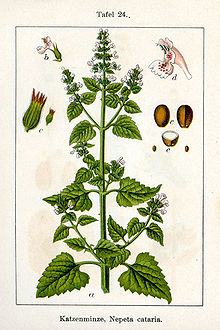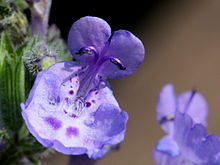- Nepeta cataria
-
"Catnip" redirects here. For other uses, see Catnip (disambiguation).
Nepeta cataria 
Catnip Scientific classification Kingdom: Plantae (unranked): Angiosperms (unranked): Eudicots (unranked): Asterids Order: Lamiales Family: Lamiaceae Genus: Nepeta Species: N. cataria Binomial name Nepeta cataria
Lamiaceae[1]Nepeta cataria (also known as catnip, catswort, or catmint) is a plant in the Lamiaceae family. The common names can also be used to refer to the Nepeta genus as a whole.
Contents
Cultivation
Variants include N. cataria var. citriodora (also called subsp. citriodora), lemon catnip.
Toxicology
The plant terpenoid nepetalactone is the main chemical constituent of the essential oil of Nepeta cataria. Nepetalactone can be extracted from catnip by steam distillation. [2]
Uses and effects
Humans
Catnip has a history of human medicinal use for its soothing properties. It has also been known to have a slightly numbing effect. The plant has been consumed as a tea, juice, tincture, infusion or poultice, and has also been smoked. [3]
Cats
Nepeta cataria (and catmints) are mostly known for the behavioral effects they have on cats, not only domestic cats but also big cats.[4] N. cataria is used as a recreational substance for pet cats' enjoyment, and catnip and laced-catnip products designed for use with domesticated cats are available to consumers. Not all cats are affected by catnip.[4] The common behaviors when cats sense the bruised leaves or stems of catnip are rubbing on the plant, rolling on the ground, pawing at it, licking it, chewing it consuming much of the plant followed by drooling, sleepiness, anxiety, leaping about and purring. Some will growl, meow, scratch, or bite the hand holding it. Some cats will eat dried catnip. Often, eating too much can cause cats to be overtly aggressive, typically making them hiss.[citation needed]
Pharmacology
Nepetalactone acts as a feline attractant. Roughly half to two thirds of cats will be affected by the plant. [5][6] This chemical enters the feline's nose. [7] Cats detect it through their olfactory epithelium, not through their vomeronasal organ. [8] At the olfactory epithelium, the nepetalactone binds to one or more olfactory receptor. Some have speculated that it may mimic a cat pheromone, such as the hypothetical feline facial pheromone or the cat urine odorant MMB.[citation needed] However, this has not been tested. Approximately two hours after an exposure, the feline will be sensitive to another dose.[citation needed] The phenomenon is hereditary; for example, most Australian cats do not react to it.[9] There is some disagreement about the susceptibility of lions and tigers to catnip.[9]
Other plants that also have this effect on cats include valerian (Valeriana officinalis) and plants that contain actinidine or dihydroactinidiolide (Smith, 2005).
Other
Nepetalactone is a mosquito and fly repellent. [10] [11] Oil isolated from catnip by steam distillation is a repellent against insects, in particular mosquitoes, cockroaches and termites.[12][13] Research suggests that in a test tube, distilled nepetalactone, the active ingredient in catnip, repels mosquitoes ten times more effectively than DEET, the active ingredient in most insect repellents,[10][14] but that it is not as effective a repellent when used on the skin. [15]
References
- ^ "Nepeta cataria information from NPGS/GRIN". www.ars-grin.gov. http://www.ars-grin.gov/cgi-bin/npgs/html/taxon.pl?25165. Retrieved 2008-04-07.
- ^ "DIY Kitty Crack: ultra-potent catnip extract". Instructables. June 3, 2007. http://www.instructables.com/id/EMDCESQF2DSDRAG/. Retrieved February 14, 2009.
- ^ Grognet, Jeff. 1990. Catnip: Its uses and effects, past and present. Canadian Veterinary Journal 31:455-456.
- ^ a b Grognet J (June 1990). "Catnip: Its uses and effects, past and present". The Canadian Veterinary Journal 31 (6): 455–456. PMC 1480656. PMID 17423611. http://www.pubmedcentral.nih.gov/articlerender.fcgi?tool=pmcentrez&artid=1480656.
- ^ http://www.cat-world.com.au/all-about-catnip
- ^ Turner, Ramona (May 29, 2007). "How does catnip work its magic on cats?". Scientific American. http://www.sciam.com/article.cfm?id=experts-how-does-catnip-work-on-cats. Retrieved February 14, 2009.
- ^ Siegel, Ronald K.. Intoxication: the universal drive for mind-altering substances. Inner Traditions / Bear & Company. p. 63. ISBN 9781594770692.
- ^ Hart, Benjamin L.; Leedy, Mitzi G. (July 1985). "Analysis of the catnip reaction: mediation by olfactory system, not vomeronasal organ". Behavioral and neural biology 44 (1): 38–46. doi:10.1016/S0163-1047(85)91151-3. PMID 3834921.
- ^ a b Durand, Marcella (March 4, 2003). "Heavenly Catnip". CatsPlay.com. http://www.catsplay.com/thedailycat/2003-04-14/mind_happycat/heavenly_catnip/heavenly_catnip.html. Retrieved February 14, 2009.
- ^ a b Kingsley, Danny (September 3, 2001). "Catnip sends mozzies flying". ABC Science Online. http://www.abc.net.au/science/news/health/HealthRepublish_355524.htm. Retrieved February 14, 2009.
- ^ Junwei J. Zhu, Christopher A. Dunlap, Robert W. Behle, Dennis R. Berkebile, Brian Wienhold. (2010). Repellency of a wax-based catnip-oil formulation against stable flies. Journal of Agricultural and Food Chemistry, 58 (23): 12320–12326 (8 Nov 2010, DOI: 10.1021/jf102811k).
- ^ Schultz, Gretchen; Peterson, Chris; Coats, Joel (May 25, 2006). "Natural Insect Repellents: Activity against Mosquitoes and Cockroaches". In Rimando, Agnes M.; Duke, Stephen O.. Natural Products for Pest Management. ACS Symposium Series. American Chemical Society. http://www.srs.fs.usda.gov/pubs/ja/ja_schultz001.pdf.
- ^ "Termites Repelled by Catnip Oil". Southern Research Station, United States Department of Agriculture – Forest Service. March 26, 2003. http://www.srs.fs.usda.gov/news/110.
- ^ Dennis Loney (2001-08-28). "Mosquito Repellents". American Chemical Society. Archived from the original on 26 April 2006. http://web.archive.org/web/20060426234808/http://www.chemistry.org/portal/a/c/s/1/feature_ent.html?id=4acf6768ce1b11d5f2944fd8fe800100. Retrieved 2007-08-28.
- ^ Chauhan, K.R.; Klun, Jerome A.; Debboun, Mustapha; Kramer, Matthew (2005). "Feeding Deterrent Effects of Catnip Oil Components Compared with Two Synthetic Amides Against Aedes aegypti". Journal of Medical Entomology 42 (4): 643–646. doi:10.1603/0022-2585(2005)042[0643:FDEOCO]2.0.CO;2. PMID 16119554.
External links
Categories:
Wikimedia Foundation. 2010.



